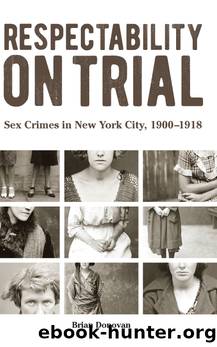Respectability on Trial by Brian Donovan

Author:Brian Donovan
Language: eng
Format: epub
Publisher: State University of New York Press
Published: 2016-03-14T16:00:00+00:00
Belle Moore and the White Slavery Narrative
The trial of Belle Moore was the most publicized compulsory case in New York City. Unlike other compulsory prostitution trials in the Transcript Collection, People v. Moore received extensive coverage in the local papers. Assistant District Attorney James Bronson Reynolds accused Belle Moore, a twenty-nine-year-old mixed-race woman, of serious crimes including running a white slave racket on the West Side, selling teenage girls into forced prostitution, and being responsible for the abduction and death of an eleven-year-old girl named Helen Hastings. The trial of Belle Moore is an important event in New York City history because it exposed the connection between anti-prostitution efforts and racial tensions. The African American community in New York City increased nearly threefold from 1890 to 1920, and an African American woman accused of enslaving white girls crystallized the fear and racism harbored by white city residents. The Belle Moore trial, according to historian Barbara Antoniazzi, was a kind of public performance that laid bare the gender and racial tensions of Progressive-Era New York City.32
The case against Belle Moore started with a chain of events initiated by journalist George Kibbe Turner. Turner was a quintessential muckraker, exposing urban corruption in a series of articles in McClureâs Magazine. A 1909 article titled âDaughters of the Poorâ accused Tammany Hall of coordinating a vast white slavery conspiracy. His article contained the hallmarks of the Progressive-Era white slavery narrative. According to the article, white slave procurers (called âcadetsâ) traveled to the industrial towns of New England to look for poorly paid factory girls to lure to New York City. One procurer, Turner noted, dressed as a priest to gain the confidence of his victims. As the cityâs vice industry expanded, white slave procurers heavily recruited from the slums and tenement houses, and Italians and Eastern European Jews haunted the cityâs dance halls to look for women to ensnare into prostitution. Turner observed, âThe amusement of the poor girl of New Yorkâespecially the very poor girlâis dancing.â33 Therefore, the dance hall became the âchief recruiting groundsâ for new white slaves.34 Turner directly blamed Tammany Hall Democrats for the cityâs vice problem and declared that the only way to address New York Cityâs prostitution problem was to defeat Tammany Hall at the ballot box.
Tammany Hall politicians responded to Turnerâs charges by initiating a grand jury investigation into white slavery. At the time, many believed that the grand jury effort was a way for Tammany Hall to whitewash or downplay the extent of prostitution; the investigation was designed to produce no evidence of white slavery and Tammany corruption. Judge Thomas OâSullivan, a strong Tammany supporter, commissioned the grand jury and appointed an inexperienced and young foreman, John Rockefeller Jr. Rockefellerâs family name gave the investigative effort a gloss of respectability, and it became known as the Rockefeller Grand Jury in the press. Tammany Hall did not expect, however, for Rockefeller to pursue his investigative work to the extent that he did. The grand jury studied the cityâs prostitution trade for over six months, long past the time they were required to meet.
Download
This site does not store any files on its server. We only index and link to content provided by other sites. Please contact the content providers to delete copyright contents if any and email us, we'll remove relevant links or contents immediately.
| Africa | Americas |
| Arctic & Antarctica | Asia |
| Australia & Oceania | Europe |
| Middle East | Russia |
| United States | World |
| Ancient Civilizations | Military |
| Historical Study & Educational Resources |
Machine Learning at Scale with H2O by Gregory Keys | David Whiting(4183)
Never by Ken Follett(3794)
Fairy Tale by Stephen King(3220)
The Man Who Died Twice by Richard Osman(2997)
Oathbringer (The Stormlight Archive, Book 3) by Brandon Sanderson(2885)
Will by Will Smith(2793)
Rationality by Steven Pinker(2291)
The Dark Hours by Michael Connelly(2245)
Can't Hurt Me: Master Your Mind and Defy the Odds - Clean Edition by David Goggins(2228)
The Dawn of Everything: A New History of Humanity by David Graeber & David Wengrow(2122)
Friends, Lovers, and the Big Terrible Thing by Matthew Perry(2119)
Principles for Dealing With the Changing World Order: Why Nations Succeed and Fail by Ray Dalio(1974)
HBR's 10 Must Reads 2022 by Harvard Business Review(1777)
A Short History of War by Jeremy Black(1762)
Go Tell the Bees That I Am Gone by Diana Gabaldon(1687)
515945210 by Unknown(1599)
A Game of Thrones (The Illustrated Edition) by George R. R. Martin(1589)
Kingdom of Ash by Maas Sarah J(1527)
443319537 by Unknown(1470)
